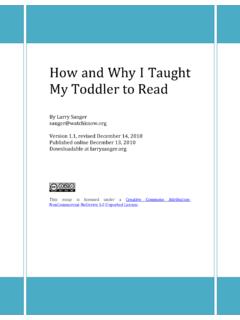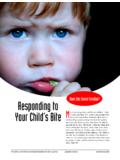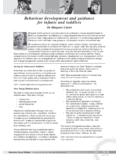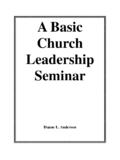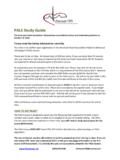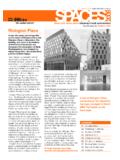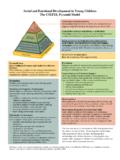Transcription of Biting, Nipping & Jumping Up
1 PREVENTING THOSE BAD biting , Nipping & Jumping Up Stopping Dog biting and Nipping THE PROBLEM WITH PUPPY AND DOG AGGRESSION Probably the most challenging aspect of working with aggression in dogs is that it often starts when the dog is a puppy. The behavior, when the puppy is small, is often considered rather cute. A tiny little puppy growling ferociously or chasing and Nipping may appear to be almost comical but once the dog is full grown, even with small breeds, the Nipping is no longer funny and the cute growling has turned taking the dog out in public into an embarrassing and stressful event. Even simple things like Jumping up become a problem as the puppy matures. A small dog Jumping up may not be frightening, but a large Labrador or German Shepard Jumping up can be a hazard to children and the elderly, plus a nuisance for everyone else. Controlling a dog s aggressive behavior is a challenging for most people.
2 It is further complicated by the fact that some dogs are more dominant than their owners, or a least more dominant than some family members. Thankfully even young children can be taught to properly respond to aggressive behaviors with the family pet and the dog will quickly learn to change their negative behavior into something more positive and acceptable. This booklet will provide positive, non-punishment based ways to address the following aggressive behaviors in dogs: Nipping biting Aggressive play Jumping up Each one of these behaviors can be eliminated from your dog s behavior by following some basic dog psychology tips and working with your pets natural instincts, rather than against them. If you have several people working with the dog be sure they are all using the same techniques. A great idea is to have one person work with the dog initially and then involve other family members as the training progresses.
3 Consistency will only increase the dog s ability to understand the changes that you are expecting. 2006 -2007. Vinayak Enterprises Pty Ltd. 2 Stopping Dog biting and Nipping STOPPING Nipping AND biting Dogs nip and bite for a variety of reasons. In interactions between dogs Nipping and biting is a way to for one dog or puppy to indicate they don t like what is going on. It is a way for puppies and dogs to say Stop to each other. As dogs mature they may nip for other reasons including demanding attention, avoiding something they don t want to do, or becoming excited or frightened. Each type of Nipping and biting will require a different type of correction and understanding why your dog is Nipping is a starting point. Think about the times that your dog has nipped. Answer the following questions: 1. What was the dog or puppy doing? 2. What was I doing (or the person that was nipped)?
4 3. Was the dog in a new environment or with new people? 4. How did I respond to the Nipping ? 5. How did the dog respond? 6. What happened after the dog nipped? biting FOR ATTENTION OR IN PLAY Dog and puppies may have learned that biting or Nipping gets them attention or that is all part of the game. This may be true for smaller breeds that nip or bite and their owner picks them up and holds them, or for puppies when the game continues even after someone is nipped or bitten. Some owners may try to pay additional attention to a dog that nips to keep it from Nipping or biting them again. In this situation the dog has trained the human, not the other way around. Depending on how long the dog or puppy has engaged in biting or Nipping , the corrective training may be very short or it may take longer. Usually attention and play type biting is more prevalent with puppies that are learning how to interact with humans.
5 To stop the attention and play biting follow these guidelines: Give a sharp, high pitched Ouch , Stop or Ow then No Bite in a lower tone, without yelling or verbally intimidating the dog or puppy 2006 -2007. Vinayak Enterprises Pty Ltd. 3 Stopping Dog biting and Nipping Immediately leave the puppy or dog alone, don t speak to them or touch them at all If the puppy or dog continues to try to bite after you give the verbal No Bite try putting a few pennies or marbles in a clean tin can. Shake the can at the dog or puppy immediately after the No Bite command. This will usually startle the dog or puppy and will reinforce the verbal instruction. If the bite or nip occurred during a game immediately stop the game and do not continue until the dog is calm and in control. When they are calm, immediately provide attention and praise. Most puppies and dogs will respond to this training when they realize that they get attention and fun when they are not biting or are practicing what dog trainers call bite inhibition.
6 biting FOR FEAR OR ANXIETY If a dog bites when in new places or when new people are present it is likely a nervous or fearful dog. How to stop a dog from biting that is behaving aggressively out of fear is very different from the technique used for the attention seeking or Nipping dog. Dogs that are nervous or fearful need additional socialization, not isolation or being ignored. Ideally socialization should occur in the first few months of a puppy s life and continue throughout the dog s life. Dogs that are kept isolated from other dogs, animals, people and new environments are naturally more fearful and self-protective when they are exposed to new things. A dog s natural defense is to bite or run so when you are out with your dog on a leash the only option the dog has to protect itself is to bite. One of the best ways to work with a dog that bites from fear or anxiety is to take him or her to an obedience class.
7 It is very important that you speak to the trainer ahead of time and follow the instructions that the trainer provides for bringing your dog into the class. Try taking your dog to as many new places as possible, but watch for signs that he or she is becoming agitated or fearful. Nervous behaviors such as the following should be monitored: Tail low or tucked between the hind legs Whining or growling Pacing Excessive panting When the dog starts exhibiting these symptoms immediately remove him or her from the environment and place him/her somewhere comfortable such as the vehicle or their crate. Praise them and pay special attention to them as they 2006 -2007. Vinayak Enterprises Pty Ltd. 4 Stopping Dog biting and Nipping gradually become more comfortable in new situations. You may also wish to consider one of the halter type leads that attach over the muzzle area to prevent any possibility of biting during the socialization period.
8 The key is to work with the dog s level of trust and comfort and gradually extend your time out as the dog becomes more confident and socialized. Jumping UP Most dogs jump up not for aggessive reasons from their perspective but as a way to get attention and become noticed. Dogs that constantly jump up usually have been petted or had attention given when they did this in the past. The most effective way to stop a dog from Jumping up is to provide a command and give positive attention before the dog actually jumps in the first place. If the dog jumps when people get home for the evening try avoiding the dog for a few minutes until it calms down. Then, when he or she is calm, let them into the house or out of the dog room and give them a command they usually follow, such as Sit . Immediately when the dog sits give a lot of positive attention. If the dog jumps up say Off or No in a firm voice and walk away.
9 The dog will learn very quickly that sitting gets much more attention than Jumping . If the dog is a chronic jumper and does this behavior no matter how long you wait for them to calm down a more direct approach is to simply carry a small squirt bottle filled with clear tap water. When the dog jumps direct a short spray of water towards the nose while saying Off or No . As soon as the dog is on all four feet give the Sit command. Remember this will only work if the dog already knows and responds to verbal commands. Praise the dog for sitting immediately. Some dogs will also respond to pennies or marbles in a can shaken when they jump. The key is to teach the dog to sit to greet you, not to jump and to give lots of love and attention when they behave appropriately. 2006 -2007. Vinayak Enterprises Pty Ltd. 5 Stopping Dog biting and Nipping A FINAL WORD One final consideration is to make sure that you are not inadvertently encouraging dog s aggression in your own actions.
10 If you have a dog that jumps, nips or bites be sure to avoid any games or activities that encourage these behaviors. Aggressive dogs should never be taught or encouraged to: Play games of tug-of-war with humans Jump up for any reason, especially for treats or attention Play any kind of chase and tackle games Wrestle with humans Some ways to keep your dog from engaging in aggressive behaviors include: Providing lots of positive attention and interactions Lots of regular exercise Keeping your dog socialized Giving your dog things to do and keeping their minds busy Taking your dog or puppy to an obedience class Teaching your dog new tricks and commands Happy and well socialized dogs have much less need for aggressive behaviors such as Jumping , Nipping and biting . Finally, be sure you understand the motivation for your dog s aggressive behavior and try to act appropriately to work through the problem before the dog or puppy gets into a negative habit of biting , Jumping or anything else you d rather avoid.
